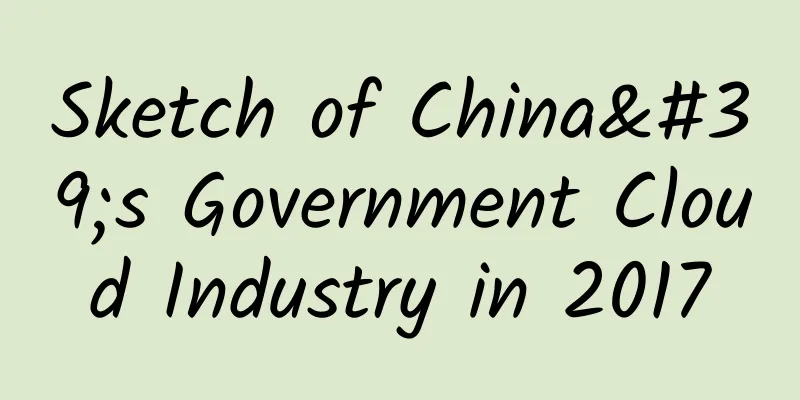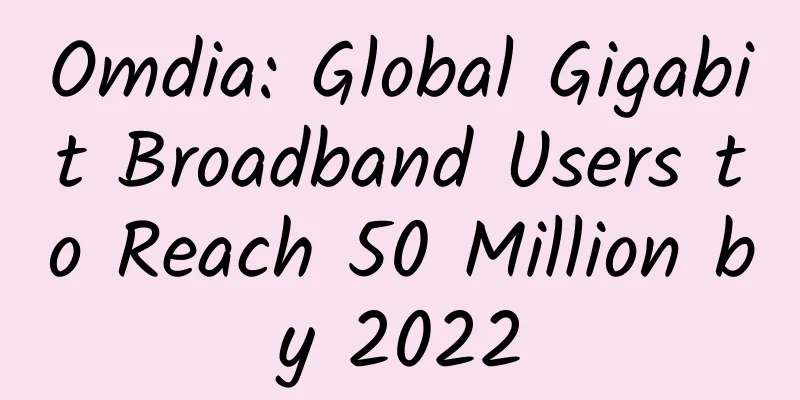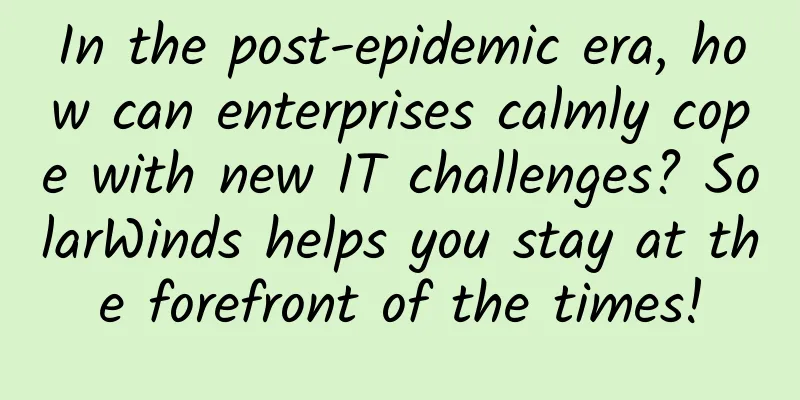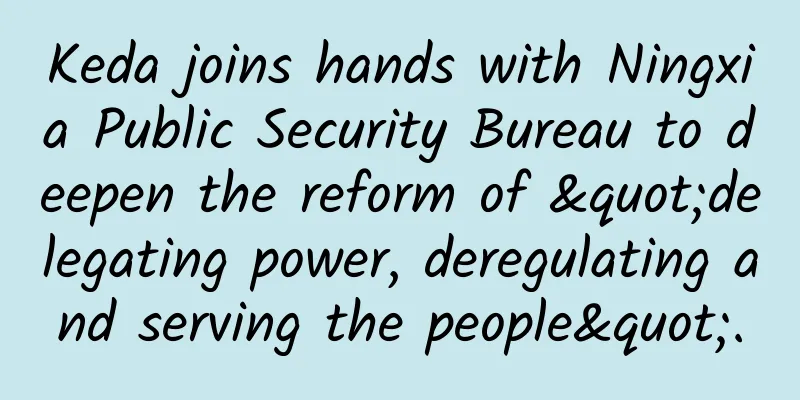Sketch of China's Government Cloud Industry in 2017

|
[51CTO.com original article] In the news of the government cloud bidding in March with a bid price of only 1 cent, the reporter smelled the gunpowder smell that could no longer be concealed in the government cloud market in 2017 through the keyword 1 cent and the reading volume of more than 100,000. Some people say that 2017 is the peak year of government cloud applications, while others see it as the year of decisive battle in the government cloud market. Regardless of which title is more accurate, what everyone agrees on is that in the momentum of the industry chain competing for supremacy and leading, China's government cloud industry has proudly passed a quarter of 2017 with a flourishing attitude. Good opportunities are hard to come by and time is running out. Recently, 51CTO reporters interviewed a number of experts, government users, and manufacturers in China's government cloud industry, trying to restore a true picture of government cloud development through their thoughts and perspectives, sketch out the various aspects of China's government cloud industry, and provide a detailed and well-founded reference for the future development of China's government cloud. The policy is clear and the pace is faster and faster If you want to understand the development of China's government cloud, you have to trace back to the birth of government cloud. There, there are the most direct expectations for the development of government cloud. At the State Council executive meeting held on June 17, 2015, Premier Li Keqiang first proposed using the "government cloud" to improve government service and regulatory efficiency. On September 14, 2016, at the State Council executive meeting, Premier Li Keqiang said that it is necessary to accelerate the promotion of "Internet + government services". All regions and departments should speed up the electronic and network-based government services and promote the construction of smart cities. Change "people running errands" to "information running errands", and change "enterprises looking for services everywhere" to "departments working together". In 2017, Premier Li Keqiang's guidance on government reform became more specific: speed up the interconnection of information systems of State Council departments and local governments, form a unified national government service platform, and realize a smart and efficient government that simplifies administration, delegates power, combines regulation and supervision, and optimizes services through "Internet + government services". What is the core of “Internet + Government Services”? It is still “Government Cloud”. It has to be admitted that in the process of national information construction, such clear and specific guiding policies are rare. The guidance of national policies has quickly attracted the active response of cloud service providers. In just less than two years, China's government cloud has become a "new market". On the one hand, hundreds of government agencies have tasted the sweetness of cloud computing; on the other hand, more government agencies are ready to respond to the national call and are eager to try. Today, the high-level planning, industry promotion, application environment, technical support, function development and other key links of government cloud have been opened up, and the embryonic form of the ecosystem has emerged. Market segmentation services will take a customized approach The reporter learned that China's government cloud applications are currently divided into two main categories. One is external, usually referring to the public service cloud provided by government departments, that is, providing public services to the public; the other is internal, referring to the e-government cloud, which mainly concentrates government business applications on a shared platform. In this type of external market, Internet companies such as BAT are the most active. They are good at providing application cases for government public services. For example, Alibaba's high-concurrency processing experience during the Double Eleven period is very convincing in front of many service-oriented government agencies with high-concurrency pain points. Moreover, Internet companies with a large user base also have inherent advantages in providing urban services to the masses. For example, Tencent's WeChat platform can aggregate various Internet government services, such as life services, government affairs, vehicle services, and transportation services launched in Shenzhen. It can provide dozens of government services such as registration platforms, electricity bill payments, and weather inquiries, which not only facilitates the people to increase their satisfaction, but also improves the efficiency of government affairs. In the field of e-government cloud, traditional ICT companies such as Huawei and Digital China are more likely to win the trust of government users. The reason is not complicated. First, companies like Huawei have long-term cooperation with the government, and the government has abundant resources. Many of the government's information systems are built by them, and they have established a long-term sense of trust, which is something that BAT companies cannot achieve in the short term; second, ICT and IT companies like Huawei have a deeper understanding of technology. Once they join hands with integrators and business partners, the solutions they launch can often better meet the needs of government users for high performance, high security, and high stability. And another key factor is that when government customers consider the factors of autonomy and control, companies like Huawei are more likely to be trusted because their core technologies are in the hands of Chinese companies, which can better guarantee the security of the government's core data. Experts in the interview said that the demand for these two different types of government cloud applications has just become clear, and the market will have great potential. In the future, cloud services will be more targeted and provide customized special services. Expert question: Have key businesses been put on the cloud? The reporter found a very strange phenomenon. When searching for "government cloud construction" on the Internet, a large number of news reports about government-related agencies going to the cloud can be found. However, after carefully reading dozens of articles, the reporter found that many government agencies have a big deviation in their understanding of "government cloud". Many departments believe that the government cloud is to store some less critical data in the cloud. Obviously, this deviates from the original intention of the development of the government cloud. Taking the Jiaxing Government Cloud, which is supported by Huawei, as an example, as of 2016, 124 business systems of 45 departments have been put online. Whether it is for enterprises to apply for licenses, ordinary people to see a doctor in a hospital, or students to share high-quality educational resources, they can all be handled through the Jiaxing Government Cloud service. In the past, when companies applied for business licenses in Jiaxing, they had to go to five government windows, such as taxation, quality inspection, and human resources insurance, or go to the government service hall and queue up five times at five windows to apply. It took one or two weeks to get a license. Now that the government system is centralized in the government cloud, you only need to go to a single window of the Industrial and Commercial Bureau and fill out a form. You can get the jointly issued license in as fast as three working days, which has significantly improved the efficiency of handling affairs and shortened the processing time by more than 1/3. Obviously, the government cloud brings a new intelligent service model, which can realize the intercommunication and collaborative sharing of government information resources across departments, levels and regions, which can not only improve the government's governance capabilities, but also improve the satisfaction of citizens and be more conducive to social development. This is by no means an effect that can be achieved by "simply storing some non-critical business data". Expert Question 2: Cloud fragmentation or intensification? Professor Tao Yong from the E-Government Center of the National School of Administration also affirmed the current development status of China's government cloud, but also pointed out some problems that have arisen during the construction. He said that the construction of government cloud in the early stage is often project-centered, department-based, with single functional activities as the main line, and efficiency improvement as the goal to promote the implementation of organizational information engineering construction. The advantage of doing so is that it quickly solves the actual problems encountered, but most of them start from small things and form relatively discrete engineering project groups. While improving the administrative efficiency of government departments, it also causes problems such as decentralization, regionalization, and fragmentation. Professor Tao Yong suggested that we will enter a new stage of development with service objects as the center and seamless integrated innovation. All government departments should adhere to the intensive, efficient and integrated construction model to better support the modernization level of governance. He believes that the construction of e-government information needs to start from three aspects: first, advanced innovative technologies should be combined with government domain knowledge; second, technical capabilities, organizational capabilities and business capabilities should be matched; interpreting technology from the perspective of the government is valuable only if there is a perspective. Experts ask three questions: Are there any standards to follow during the entire implementation process? Gao Wei, chief engineer of the Internet Center of the Institute of Technology and Standards of the China Academy of Information and Communications Technology, said that some foreign practices also have certain reference value for the construction of China's government cloud, such as establishing a government cloud security standard system, conducting security reviews of cloud service providers, and introducing professional third-party evaluation agencies. Gao Wei believes that the framework of my country's government cloud security standards system has been initially formed, and detailed standards are yet to be issued. The release of GB/T 31168-2014 "Information Security Technology Cloud Computing Service Security Capability Requirements" and GB/T 31167-2014 "Information Security Technology Cloud Computing Service Security Guidelines" currently released in China can lay the foundation for the formation of my country's government cloud security standards system. He pointed out that the "Information Security Technology Cloud Computing Service Security Capability Requirements" puts forward very detailed security requirements for service providers providing cloud computing services to the government in ten aspects, including "system development and supply chain", "system and communication protection", "access control", "configuration management", "maintenance", "emergency response and disaster recovery", "audit", "risk assessment and continuous monitoring", "security organization and personnel", and "physical and environmental security". It provides strong standard support for cloud service providers to implement government cloud computing application projects and for the government to conduct security reviews of cloud computing services for party and government departments. "At the same time, we should also see that the current two national standards are still relatively macro and holistic requirements." He pointed out that in the subsequent specific work, it is also necessary to conduct research and formulation of specific standards such as specific operating procedures for cloud service security reviews and evaluation of the implementation effects of cloud service security reviews as soon as possible. Manufacturers are busy "encircling the land" to enter the ecosystem from their own perspective The continued rise of the government cloud market is inseparable from the active layout of cloud service providers. From a macro perspective, each cloud service provider enters the government cloud market based on its own business strengths. Because of this, the government cloud market also presents a vibrant vitality of "thousands of ships competing". At the Huawei Ecosystem Partner Conference in March, Huawei invited smart city partners and industry cloud partners to discuss cloud ecosystem construction. It can be seen that Huawei's main foothold in government cloud is smart city and industry cloud, and the core is still based on the construction of city and industry data centers, communication capabilities and the Internet of Things. It hopes that new ICT will attract many partners to build a cloud ecosystem together, so as to grow and become stronger in a healthy and benign way. Internet companies, on the other hand, have a mixed bag of situations. Although they have a powerful ecosystem, their usual strategy of "spending money to grab market share" does not work in the government industry. "Big players" like Alibaba and Tencent can provide a lot of reference for government users based on their own construction experience. However, it is difficult for small-scale Internet companies to win the trust of customers. This is also the reason why vicious competition is sometimes caused by "price competition". According to CCW Research's forecast, the investment scale of my country's government cloud market will reach 10.19 billion in 2017, while the government information investment amount is expected to be 68.9 billion during the same period. Government cloud will account for 14.8% of the total government information investment. By 2020, the investment scale of government cloud will account for 28.7% of the government information investment. It can be seen that the competition in the government cloud market will continue to intensify in the future, and the existing cloud service providers may soon experience another wave of market "big wave gold rush". Let us wait and see how the future government cloud industry will subvert the existing government service model. [51CTO original article, please indicate the original author and source as 51CTO.com when reprinting on partner sites] |
<<: ADX application delivery ensures your business continuity and improves your access experience
Recommend
The next generation of Internet communication networks is about to be deployed. Is IPv6 security protection ready?
Recently, the General Office of the Communist Par...
Cisco Chairman and CEO Chuck Robbins delivered a speech at the China Development Forum 2020: Innovation and cooperation promote prosperity and development
On November 11, 2020, the 2020 China Development ...
5G and machine learning: Transforming cell towers from smart to genius
[[335632]] 5G ushers in new “genius” networks to ...
Endpoint Technology: A one-stop digital transformation platform for enterprises
[51CTO.com original article] Endpoint Technology ...
Healthcare and smart city services will lead 5G IoT adoption
Juniper Research predicts that by 2026, there wil...
Are you still worried about the slow WiFi? There are five pitfalls behind it
The Internet of Everything makes network communic...
Master traffic suppression and storm control to take your business to the next level
1. Traffic Suppression 1. Overview Problems in th...
Tsinghua Unigroup's H3C wins China Mobile's 2020-2022 IPS centralized procurement project with the largest share
Recently, China Mobile announced the bidding resu...
618 is here, it’s time to upgrade your WiFi 6 router!
[[404856]] 618 is here, and during the annual sho...
Huawei Releases Next-Generation Intelligent Storage OceanStor Dorado V6 to Build a New Data Infrastructure
[51CTO.com original article] [Beijing, China, Jul...
[Black Friday] TMThosting: VPS monthly payment up to 55% off, dedicated server 10% off, Seattle data center, Alipay support
TMThosting has launched this year's Black Fri...
Academician Wu Hequan: "Spectrum Blockchain" can be used to solve the 5G spectrum shortage problem
At the 2020 China Radio Conference which opened y...
An introduction to different types of edge computers
Before buying edge computer hardware, we must fir...
Blockchain subverts the underlying architecture of the financial industry and opens a new era of value interconnection
Blockchain is essentially a decentralized databas...
LOCVPS 10th Anniversary Sale 20% off, top up 1000 yuan and get 100 yuan
LOCVPS has started the 10th anniversary event war...









